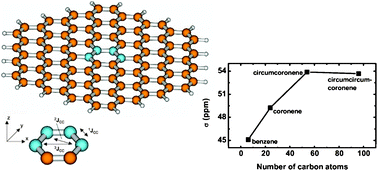NMR tensors in planar hydrocarbons of increasing size†
Abstract
13C nuclear shielding and 13C–13C spin–spin coupling tensors were calculated using density functional theory linear response methods for a series of planar

* Corresponding authors
a Laboratory of Physical Chemistry, Department of Chemistry, P.O. Box 55 (A.I. Virtasen aukio 1), FIN-00014 University of Helsinki, Finland
b NMR Research Group, Department of Physics, P.O. Box 3000, FIN-90014 University of Oulu, Finland
c CSC–IT Center for Science Ltd., P.O. Box 405, FIN-02101 Espoo, Finland
d
NMR Research Group, Department of Physics, P.O. Box 3000, FIN-90014 University of Oulu, Finland
E-mail:
juha.vaara@oulu.fi
13C nuclear shielding and 13C–13C spin–spin coupling tensors were calculated using density functional theory linear response methods for a series of planar

 Please wait while we load your content...
Something went wrong. Try again?
Please wait while we load your content...
Something went wrong. Try again?
S. Ikäläinen, P. Lantto, P. Manninen and J. Vaara, Phys. Chem. Chem. Phys., 2009, 11, 11404 DOI: 10.1039/B919860A
To request permission to reproduce material from this article, please go to the Copyright Clearance Center request page.
If you are an author contributing to an RSC publication, you do not need to request permission provided correct acknowledgement is given.
If you are the author of this article, you do not need to request permission to reproduce figures and diagrams provided correct acknowledgement is given. If you want to reproduce the whole article in a third-party publication (excluding your thesis/dissertation for which permission is not required) please go to the Copyright Clearance Center request page.
Read more about how to correctly acknowledge RSC content.
 Fetching data from CrossRef.
Fetching data from CrossRef.
This may take some time to load.
Loading related content
